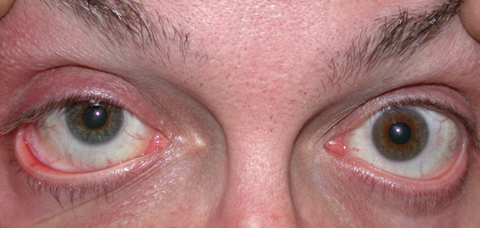 |
Everybody loves blue eyes. According to a recent study, people rate blue eyes as one of the five most attractive characteristics when assessing beauty.1 Perhaps this is because blue eye color is comparatively rare. In the United States, about 27% of individuals have blue eyes, according to one survey.2 So, what is an unhappy, brown-eyed individual to do?
Since the mid-1980s, many have opted for cosmetic soft contact lenses to help satisfy their desire for differently colored eyes. Veteran optometrists will likely remember (with varying degrees of fondness) the Durasoft 3 Colors line (Wesley Jessen), or the Mystique line (Coopervision). These lenses became a fashion trend in the 1990s, growing to even greater popularity after the introduction of disposables.
But with this new fad came difficulties. The demand for colored contact lenses led to instances of unlicensed sale and dispensing by unqualified individuals, in such unlikely places as beauty shops and flea markets. This in turn led to increased cases of sight-threatening complications, such as microbial keratitis.3 While opaque cosmetic contact lenses are still available today, they are viewed with greater skepticism and dispensed far less frequently than in their heyday.
Another, more radical effort to alter eye color arose several years ago when physicians in Central America began using the NewColorIris implant (Kahn Medical Devices). The device, and others like it, consists of an annular silicone iris diaphragm with a central opening and several small peripheral flaps designed to anchor it in the anterior chamber. Prosthetic iris devices like these are not new; they were originally developed to treat pathologic conditions such as iris colobomas, traumatic iris defects and aniridia.4
But the makers of NewColorIris instead began marketing its implant to healthy patients as “a safe and permanent way to modify eye color,” with a “favorable risk profile over cosmetic contact lenses.”5,6
In reality, a substantial number of patients who had these devices implanted experienced complications and irreversible vision loss.5-15
 |
| Patients with heterochromia, as seen here, have some procedural options, but with varying degrees of safety. Click photo to enlarge. Photo: Aaron Bronner, OD |
Complications
Glaucoma was the most common complication associated with these implants.6 Out of 128 cases reported between 2008 and 2016, 59 developed secondary glaucoma as a result of the procedure.6 Elevations of intraocular pressure (IOP) were recorded as high as 68mm Hg.13 Forty-four of the 128 eyes suffered severe endothelial cell loss, with some having subsequent corneal decompensation.6 The etiology of these complications is likely threefold:
(1) Compression of the trabecular meshwork, possibly causing chronic inflammation.
(2) Contact between the implant’s flaps and peripheral endothelial cells, causing cell death.
(3) Direct contact with the iris, leading to atrophy and pigment dispersion.6
Although warranted in these cases, removal of these devices introduced additional complications, including hyphema, suprachoroidal hemorrhage and iatrogenic iris defects.14,15
Laser Options
Despite the significant risks demonstrated through prior modalities, there are still potential avenues for those wishing to modify their natural eye color.
The latest reported procedure to emerge involves laser treatment to the iris surface. NewEyes Laser (Clínica Eyecos) has been advertising this technology on its website for several years. Another organization called Mantis, located in Istanbul, Turkey, describes itself as “a high scale and quality organization that delivers a safe and advanced eye color changing procedure to its patients.”16 In the United States, a company called Stroma Medical is developing a platform to deliver this technique into the hands of willing ophthalmologists, projecting an estimated base of 2.34 million patients a year, with a potential revenue for physicians of $10.5 Billion.17 In 2015, the American Academy of Ophthalmology warned consumers about laser surgery to change eye color, stating that “the procedure has yet to undergo clinical trial testing in the United States to determine any potential safety risks.”18 The organization expressed concern that liberation of pigment during the procedure could cause glaucoma, and warned of other potential risks such as uveitis.18
The proposed mechanism of action for this treatment involves destruction of intracytoplasmic melanosomes in the anterior iris; the melanin granules absorb laser energy via a process known as selective photothermolysis.19,20 It is this same principle that is used in selective laser trabeculoplasy (SLT), which causes structural changes in the trabecular meshwork that help to reduce IOP.18
Since all irises contain only brown pigment, and the perceived hue is merely the result of pigment density, it is theoretically possible to lighten the color of the iris by reducing the amount of melanin in the tissue.
Lasers in the Literature
Only two reports in the published literature detail this procedure. The first was an experimental animal model in which energy from a frequency-doubled 532nm wavelength Nd:YAG laser was applied to the iris surface.19 The animals, all of whom had brown irises, were treated in a series of three sessions spaced two weeks apart. Clinical examinations were conducted after each session to assess iris color (as compared with baseline), postoperative inflammation and IOP. The authors reported a noticeable iris color change, which was most evident at 60 days following the initial procedure. The researchers noted no statistically significant elevation of IOP in any of the subjects and only a mild inflammatory reaction that was energy dependent (i.e., eyes treated with a higher energy pulse had greater inflammation) and resolved without treatment.18 Additionally, none of the eyes showed complications such as corneal edema, hypopyon, posterior synechia, transillumination defects, lens opacity, vitreous haze or alteration of pupillary function.19
The second report detailed a single patient who was treated with an identical 532nm Nd:YAG laser for unilateral sectoral heterochromia iridis.20 The treatment involved three sessions over three consecutive days, and the cycle was repeated one month later. Pilocarpine 2% was instilled prior to each laser application for miosis, and nepafenac 0.1% was given QID for one week after treatment to suppress inflammation. The procedure was successful in producing a homogenously blue iris, more closely resembling the fellow eye. There were no postoperative complications reported.20
It is too early to tell if laser treatment will emerge as a viable method for altering eye color. More clinical trials are certainly necessary to determine if this procedure is indeed safe, effective and predictable. But if the past is any indication, there will certainly be no shortage of individuals willing to give it a try. As optometrists, we must remain informed about new techniques like these to provide accurate information to our patients and effectively safeguard their ocular health.
| 1. Gründl M, Knoll S, Eisenmann-Klein M, Prantl L. The blue-eyes stereotype: do eye color, pupil diameter, and scleral color affect attractiveness? Aesthetic Plast Surg. 2012 Apr;36(2):234-40. 2. Gudgel D. Your blue eyes aren’t really blue. American Academy of Ophthalmology: Eye Facts and Science. www.aao.org/eye-health/tips-prevention/your-blue-eyes-arent-really-blue. November 30, 2016. Accessed August 1, 2017. 3. Steinemann T, Pinninti U, Szczotka L, et al. Ocular complications associated with the use of cosmetic contact lenses from unlicensed vendors. Eye Contact Lens. 2003 Oct;29(4):196-200. 4. Mamalis N. Cosmetic iris implants. J Cataract Refract Surg. 2012 Mar;38(3):383. 5. Hoguet A, Ritterband D, Koplin R, et al. Serious ocular complications of cosmetic iris implants in 14 eyes. J Cataract Refract Surg. 2012 Mar;38(3):387-93. 6. Galvis V, Tello A, Corrales M. Postoperative results of cosmetic iris implants.J Cataract Refract Surg. 2016 Oct;42(10):1518-26. 7. Shah R, Randleman J. New color iris implants. Ophthalmology. 2012 Jul;119(7):1495-1495.e2. 8. Sikder S, Davis S, Holz H, Moshirfar M. Complications of NewColorIris implantation in phakic eyes: a review. Clin Ophthalmol. 2011;5:435-8. 9. George M, Tsai J, Loewen N. Bilateral irreversible severe vision loss from cosmetic iris implants. Am J Ophthalmol. 2011 May;151(5):872-875.e1. 10. Arthur S, Wright M, Kramarevsky N, et al. Uveitis-glaucoma-hyphema syndrome and corneal decompensation in association with cosmetic iris implants. Am J Ophthalmol. 2009 Nov;148(5):790-3. 11. Thiagalingam S, Tarongoy P, Hamrah P, et al. Complications of cosmetic iris implants. J Cataract Refract Surg. 2008 Jul;34(7):1222-4. 12. Garcia-Pous M, Udaondo P, Garcia Delpech S, et al. Acute endothelial failure after cosmetic iris implants (NewIris). Clin Ophthalmol. 2011;5:721-3. 13. Malik S, Ghauri A, Al-Mousa R, et al. Removal of artificial iris implants due to bilateral angle closure glaucoma and corneal decompensation. Presented at the XXXII Congress of the European Society of Cataract and Refractive Surgeons. London, UK. September 2014. 14. Mansour A, Ahmed II, Eadie B, et al. Iritis, glaucoma and corneal decompensation associated with BrightOcular cosmetic iris implant. Br J Ophthalmol. 2016 Aug;100(8):1098-101. 15. Anderson J, Grippo T, Sbeity Z, Ritch R. Serious complications of cosmetic NewColorIris implantation. Acta Ophthalmol. 2010 Sep;88(6):700-4. 16. About Mantis. www.mantiseyes.com. Mantis. Accessed August 14, 2017. 17. Laser based unit would permanently change eye color. YouTube. youtu.be/WAh3zCRt_mg. November 9, 2016. Accessed August 4, 2017. 18. Dang S. Laser surgery to change eye color untested for safety risks. American Academy of Ophthalmology: EyeSmart. www.aao.org/eye-health/news/laser-surgery-to-change-eye-color. April 7, 2015. Accessed August 2, 2017. 19. Yildirim Y, Duzgun E, Kar T, et al. Evaluation of color-changing effect and complications after Nd: YAG laser application on iris surface. Med Sci Monit. 2016 Jan 11;22:107-14. 20. Basoglu A, Çelik U. The effect of SLT laser application on iris to treat sectorial heterochromia: A promising technique. Eye Contact Lens. 2017 Jul 14. [Epub ahead of print]. |

